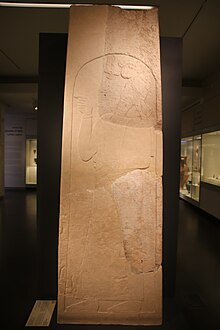| Iran Stele | |
|---|---|
 The Iran Stele on display at the Israel Museum, 2018 The Iran Stele on display at the Israel Museum, 2018 | |
| Material | Dolomite (rock) |
| Height | 240 cm (94 in) |
| Writing | Akkadian |
| Created | c. 737 BCE |
| Period/culture | Reign of Tiglath-Pileser III of the Neo-Assyrian Empire |
| Discovered | Zagros Mountains, Iran |
| Present location | Jerusalem, Israel |
| Period | Iron Age |
The Iran Stele is a stele from the Neo-Assyrian Empire. Dated to around 737 BCE, it is written in Akkadian and was discovered in the Zagros Mountains of Iran, hence the name.
The Assyrian king Tiglath-Pileser III was instrumental in expanding the Neo-Assyrian Empire westward, reaching the Levant and encountering Israel and Judah. The Iran Stele was discovered in three large fragments and details his military campaigns during the first nine years of his reign.
Of particular interest to ancient Israel is a section of the inscription listing the kings who paid tribute to him, including Menahem of Samaria. Two of the Iran Stele fragments are now housed at the Israel Museum in Jerusalem after being part of various private collections.
Text:
“Menahem of Samaria, Hiram of Tyre, . . . gold, silver . . .”
“. . the place of Samaria only did I leave their king”
References
- The Inscriptions of Tiglath-Pileser III, King of Assyria. Hayim Tadmor. 2007. ISBN 978-9652081759.
- "Stele of Tigla...Stele of Tiglath-Pilesar III (biblical Pul), founder of the Assyrian Empire". museums.gov.il.
- "Archaeological Evidence of Kings of Israel and Judah". ArmstrongInstitute.org. Retrieved 2024-03-31.
- Hayes, John H.; Hooker, Paul K. (2007-06-08). A New Chronology for the Kings of Israel and Judah and Its Implications for Biblical History and Literature. Wipf and Stock Publishers. ISBN 978-1-7252-2007-2.
- Vcyamerica (2019-06-29). "June 29 – Tiglath Pileser III". VCY.org. Retrieved 2024-05-03.
- "Tiglath-pileser III 35 [via RINAP/RINAP1]". oracc.museum.upenn.edu.
- "Iran Stele, 737 BCE : Center for Online Judaic Studies". Retrieved 2024-03-13.
- "Stele of Tiglath-Pilesar III". www.imj.org.il. Retrieved 2024-03-13.
- "RINAP 1 Tiglath-pileser III 35, ex. 001 (P429999)". CDLI. Retrieved 2024-03-13.
- "The Annals of Tiglath-pileser - Livius". www.livius.org. Retrieved 2024-03-17.
- "The Syro-Ephraimite War and its implications" (PDF).
External links
- King Menahem an archaeological biography
- Menahem of Samaria
- Kings of Judah & Israel Attested in Archaeology